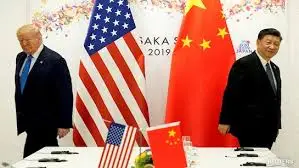US-China trade deal: Why both sides are keen to break the stalemate

The economic standoff between the United States and China, which began under former President Donald Trump’s administration, has lingered for years, sending shockwaves through global supply chains and economic systems. However, recent signs suggest both Washington and Beijing are increasingly inclined to break the deadlock and move toward a new phase of engagement. But what’s driving this urgency — and why now?
The Trade War’s Long Shadow
The trade war officially began in 2018, when the U.S. slapped tariffs on Chinese goods worth hundreds of billions of dollars, citing unfair trade practices, intellectual property theft, and a growing trade imbalance. China responded with its own retaliatory tariffs, targeting American agricultural products, manufacturing components, and more.
Over time, these punitive measures have taken a toll. While the U.S. economy remained relatively resilient thanks to its diversified economic base, specific sectors like agriculture, consumer electronics, and automotive parts experienced heavy losses. China, on the other hand, faced slowing exports and investor uncertainty as foreign companies began to diversify their supply chains.
A partial truce was achieved in early 2020 with the “Phase One” trade agreement. Under it, China pledged to increase purchases of U.S. goods by $200 billion and improve intellectual property protections. However, the COVID-19 pandemic disrupted trade flows, and both sides fell short of their targets.
Economic Pressure on Both Fronts
Fast forward to 2025, and both countries are facing fresh economic headwinds. In the U.S., inflation remains a concern despite aggressive interest rate hikes. Meanwhile, China is grappling with a sluggish post-COVID recovery, a real estate crisis, and declining foreign investment.
The Biden administration is under pressure to bring down consumer prices — especially on imported goods affected by tariffs. With an election year approaching, reducing economic pressure on American households could provide a political boost.
For China, exports remain a critical engine of growth. With Western companies increasingly shifting production to Southeast Asia or back to their home countries — a phenomenon known as “decoupling” — Beijing faces the risk of long-term economic isolation. Re-engaging with the U.S. could restore some investor confidence and stabilize trade routes.
Global Supply Chain Disruptions
Beyond their bilateral interests, both nations are contending with a disrupted global supply chain. The COVID-19 pandemic, followed by the Russia-Ukraine war, has already stretched logistics networks. The Israel-Gaza conflict has only heightened regional tensions, impacting oil prices and shipping lanes.
These complications are pushing both Washington and Beijing to consider more stable economic relations. Reopening dialogue could help avoid further disruptions in technology, automotive parts, and semiconductors — sectors critical to the global economy.
Strategic Competition Still Looms
While there are incentives to cooperate economically, the broader strategic rivalry between the U.S. and China is far from resolved. Issues like Taiwan, South China Sea navigation rights, cyber security, and human rights continue to divide the two powers.
The U.S. has tightened controls on advanced semiconductor exports to China, citing national security risks. China has responded by limiting exports of rare earth metals essential to the tech industry. These tit-for-tat measures reveal that even as trade negotiations restart, underlying tensions persist.
However, analysts say that decoupling entirely is not feasible, especially in the short term. The U.S. still relies heavily on Chinese manufacturing, while China depends on U.S. demand and financial markets.
Signs of a Thaw?
Recent diplomatic efforts suggest a thaw may be underway. In November 2023, President Joe Biden and Chinese President Xi Jinping met in San Francisco on the sidelines of the APEC summit — the first in-person meeting between the two leaders in over a year. While no major breakthrough occurred, both sides agreed to resume military communications and cooperate on climate change.
Additionally, high-level visits from U.S. Treasury Secretary Janet Yellen and Commerce Secretary Gina Raimondo to China have rekindled hopes of economic rapprochement. Behind closed doors, discussions are reportedly ongoing about rolling back some tariffs and revising the Phase One agreement.
China has also expressed interest in joining the Comprehensive and Progressive Agreement for Trans-Pacific Partnership (CPTPP), a trade bloc originally designed to exclude Beijing. While U.S. policymakers remain skeptical, the gesture signals China’s intent to re-integrate into global trade norms.
What’s Next?
As both sides recalibrate their economic strategies, a full-scale trade deal may still be distant. However, incremental steps — such as lowering certain tariffs, improving transparency on technology exports, and setting up new dispute resolution mechanisms — could pave the way for a more stable relationship.
For businesses and consumers, even modest progress could bring relief. Reduced tariffs would lower input costs for American companies and ease price pressure on everyday goods. For Chinese manufacturers, it could open up new markets and reduce export bottlenecks.
At a time when the global economy is already fragile, renewed U.S.-China engagement is not just desirable — it’s essential.






